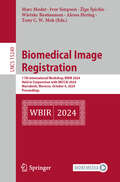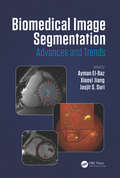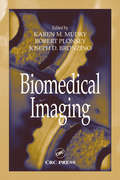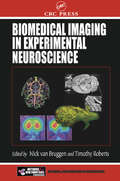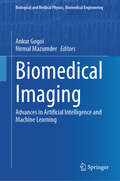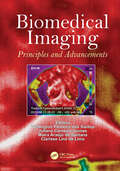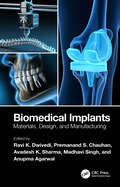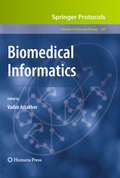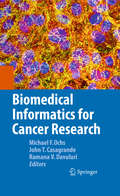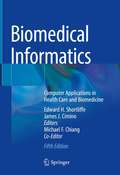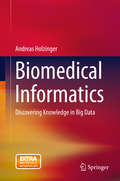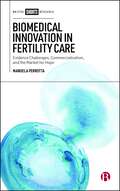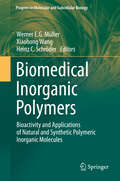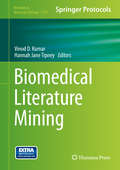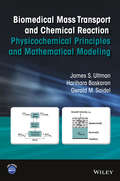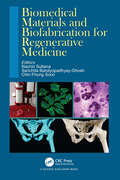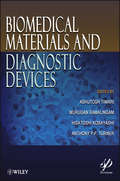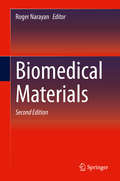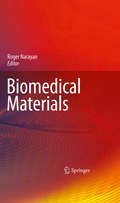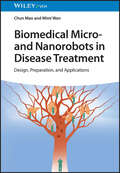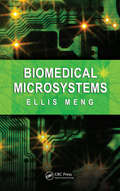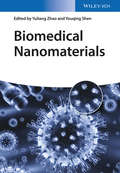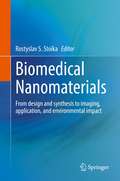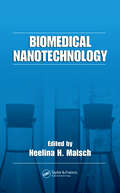- Table View
- List View
Biomedical Image Analysis (Biomedical Engineering)
by Rangaraj M. RangayyanComputers have become an integral part of medical imaging systems and are used for everything from data acquisition and image generation to image display and analysis. As the scope and complexity of imaging technology steadily increase, more advanced techniques are required to solve the emerging challenges.Biomedical Image Analysis demonstr
Biomedical Image Registration: 11th International Workshop, WBIR 2024, Held in Conjunction with MICCAI 2024, Marrakesh, Morocco, October 6, 2024, Proceedings (Lecture Notes in Computer Science #15249)
by Marc Modat Ivor Simpson Žiga Špiclin Alessa Hering Wietske Bastiaansen Tony C. W. MokThis book constitutes the refereed proceedings of the 11th International Workshop on Biomedical Image Registration, WBIR 2024, held in conjunction with the 27th International conference on Medical Image Computing and Computer Assisted Intervention, MICCAI 2024, in Marrakesh, Morocco in October 2024. The 28 full papers presented in this book were carefully reviewed and selected from 32 submissions. These papers have been categorized under the following topical sections: Architectures; Robustness; Atlas/ Fusion; Feature/ Similarity Learning & Efficiency.
Biomedical Image Segmentation: Advances and Trends
by Jasjit S. Suri Xiaoyi Jiang Ayman El-BazAs one of the most important tasks in biomedical imaging, image segmentation provides the foundation for quantitative reasoning and diagnostic techniques. A large variety of different imaging techniques, each with its own physical principle and characteristics (e.g., noise modeling), often requires modality-specific algorithmic treatment. In recent years, substantial progress has been made to biomedical image segmentation. Biomedical image segmentation is characterized by several specific factors. This book presents an overview of the advanced segmentation algorithms and their applications.
Biomedical Imaging (Principles and Applications in Engineering)
by Robert Plonsey Karen M. Mudry Joseph D. BronzingComprised of chapters carefully selected from CRC‘s best-selling engineering handbooks, volumes in the Principles and Applications in Engineering series provide convenient, economical references sharply focused on particular engineering topics and subspecialties. Culled from the Biomedical Engineering Handbook, Biomedical Imaging
Biomedical Imaging in Experimental Neuroscience (Frontiers in Neuroscience)
by Bruggen Timothy RobertsWith the emergence of genetically manipulated laboratory mice as one of the most powerful tools for neuroscientists, imaging techniques capable of providing anatomical and functional information of small animals have become extremely important. Emphasizing data analysis and interpretation, Biomedical Imaging in Experimental Neuroscience presents a comprehensive review of the noninvasive biomedical imaging techniques available for laboratory animal research. It covers the scope and limitations of these methods and analyzes their impact on in vivo neuroscience research. The book also provides a concise theoretical description of the pertinent physics.
Biomedical Imaging: Advances in Artificial Intelligence and Machine Learning (Biological and Medical Physics, Biomedical Engineering)
by Ankur Gogoi Nirmal MazumderThis book presents the rapidly developing field of artificial intelligence and machine learning and its application in biomedical imaging. As is known, starting from the diagnosis of fractures by using X-rays to understanding the complex structure and function of the brain, biomedical imaging has contributed immensely toward the development of precision diagnosis and treatment strategies for numerous diseases. While continuous evolution in imaging technologies have enabled the acquisition of images having resolution and contrast far better than ever, it significantly increased the volume of data associated with each image scan—making it increasingly difficult for experts to analyze and interpret. In this context, the application of artificial intelligence (AI) and machine learning (ML) tools has become one of the most exciting frontlines of contemporary research in biomedical imaging due to their capability to extract minute traces of various disease signatures from large and complicated datasets and providing clear insight into the potential abnormalities with excellent accuracy, sensitivity, and specificity. The hallmark of this book will be the contributions from international leaders on different AI-aided advanced biomedical imaging modalities and techniques. Included will be comprehensive description of several of the technology-driven spectacular advances made over the past few years that have allowed early detection and delineation of abnormalities with sub-pixel image segmentation and classification. Starting from the fundamentals of biomedical image processing, the book presents a streamlined and focused coverage of the core principles, theoretical and experimental approaches, and state-of-the-art applications of most of the currently used biomedical imaging techniques powered by AI.
Biomedical Imaging: Principles and Advancements
by Juliana Carneiro Gomes Wellington Pinheiro dos Santos Maíra Araújo de Santana Clarisse Lins de Lima"Biomedical Imaging: Principles and Advancements" offers a captivating exploration of the intricate landscapes within the human body, revealing the transformative power of biomedical imaging. Edited by Wellington Pinheiro dos Santos, Juliana Carneiro Gomes, Maíra Araújo de Santana, and Clarisse Lins de Lima, this anthology delves into foundational concepts, from acquisition to ethical considerations, paving the way for in-depth examinations of magnetic resonance imaging, infrared thermography, and electrical impedance tomography. The real-world applications covered in Section II, from Alzheimer's diagnosis to Covid-19 assessment, showcase the diverse impact of these imaging techniques on healthcare. A collective effort, this volume inspires continued exploration in the ever-evolving field of biomedical imaging.
Biomedical Implants: Materials, Design, and Manufacturing
by Ravi K. Dwivedi, Premanand S. Chauhan, Avadesh K. Sharma, Madhavi Singh, and Anupma AgarwalThis book provides a comprehensive overview of the development of implants, from the selection of materials to the outcome of the process. It covers various steps, including biocompatible material, synthesis, and characterization, compatibility and limitations of materials, specific implants, and finite element analysis of medical implants. It also presents a comparison between predictions and experimental results by studying real-world problems and addresses the issue of sustainability in implant manufacturing, process modeling, and optimization in additive manufacturing supported by case studies. Features:• Covers the development of implants from the selection of material to the suitable process of manufacturing technologies.• Includes biocompatible material, synthesis, characterization, compatibility, and limitations of materials.• Reviews biofabrication in terms of artificial organs and soft tissues.• Discusses implant manufacturing, including additive and micro-manufacturing and failure analysis through case studies.• Addresses the issue of sustainability in implant manufacturing. This book is intended for researchers and graduate students specializing in mechanical, biomedical, healthcare engineering, biomaterials, and additive manufacturing.
Biomedical Informatics (Methods in Molecular Biology #569)
by Vadim AstakhovIn past decades, the area of bioinformatics has proved to be both dynamic and vital, producing a wide spectrum of novel approaches and assuming an increasingly important role in modern bio-technological development. In Biomedical Informatics, expert researchers explore cutting-edge new advances in the field, providing an overview of novel cyberinfrastructures which are currently under development in various bio-medical centers across the world. Chapters demonstrate various architectures for large-scale collaboration, offer modern approaches currently used in various areas of bioinformatics, and highlight the software challenges associated with large-scale biomedical informatics. Composed in the highly successful Methods in Molecular BiologyTM series format, chapters include a brief introduction, detailed methods, and a Notes section which shares tips on troubleshooting and avoiding known pitfalls. Wide-ranging and innovative, Biomedical Informatics is an essential manual for newcomers to this area, as well as an invaluable addition to the laboratories and offices of the most practiced researchers.
Biomedical Informatics for Cancer Research
by Michael F. Ochs Ramana V. Davuluri John T. CasagrandeThis book will review work from a number of researchers who have produced open source software addressing the need for data management, integration, analysis, and visualization to aid cancer research. With the advent of high-throughput technologies in biomedicine, the need for data management and appropriate data analysis tools in genomics has increased dramatically, joining clinical trials data as a major driver of informatics at cancer research centers. The gathering of this data requires careful encoding of metadata, usually through the use of controlled vocabularies or ontologies, as well as the linking of data from model organisms, done at both a physiological level (e.g., anatomy) and at a molecular level (e.g., orthology). This data will then find use within computational and statistical models, which require data pipelines and analysis systems, as well as algorithms, visualization methods, and computational modeling systems. We will introduce open source tools available for these aspects of the problem. The editors plan to divide the book into five sections, beginning with a section containing high level overviews of the field and key issues. This will include an introductory review of informatics in cancer research, followed by five overviews addressing issues in authentication and authorization, data management, data pipelines and annotations, algorithms and models, and the NCI caBIG initiative. This will be followed by sections dedicated to data systems, data pipelines, algorithms for analysis and visualization, and modeling systems. Each of these areas has seen publication of open source tools, ranging from the widely known R/Bioconductor package to little known but powerful systems such as SImmune for biochemical modeling. The area of laboratory information management systems has seen development of a number of unpublished but powerful systems, which we would also include. Three groups have agreed to provide chapters in this area (USC/Norris CAFE extensible clinical trials system, St Jude Unified LIMS, Fox Chase/British Columbia flow cytometry LIMS). While there has been a great deal of development of informatics tools that can be applied to problems in cancer research, there has not been adequate dissemination of details on these tools to the community. As such, there remains low adoption of all but a few tools. This book aims to increase overall adoption of tools by providing cancer center leaders and researchers with a single volume detailing both issues that must be addressed and tools that are ready for use.
Biomedical Informatics: Computer Applications in Health Care and Biomedicine
by Michael F. ChiangThis 5th edition of this essential textbook continues to meet the growing demand of practitioners, researchers, educators, and students for a comprehensive introduction to key topics in biomedical informatics and the underlying scientific issues that sit at the intersection of biomedical science, patient care, public health and information technology (IT). Emphasizing the conceptual basis of the field rather than technical details, it provides the tools for study required for readers to comprehend, assess, and utilize biomedical informatics and health IT. It focuses on practical examples, a guide to additional literature, chapter summaries and a comprehensive glossary with concise definitions of recurring terms for self-study or classroom use.Biomedical Informatics: Computer Applications in Health Care and Biomedicine reflects the remarkable changes in both computing and health care that continue to occur and the exploding interest in the role that IT must play in care coordination and the melding of genomics with innovations in clinical practice and treatment. New and heavily revised chapters have been introduced on human-computer interaction, mHealth, personal health informatics and precision medicine, while the structure of the other chapters has undergone extensive revisions to reflect the developments in the area. The organization and philosophy remain unchanged, focusing on the science of information and knowledge management, and the role of computers and communications in modern biomedical research, health and health care.
Biomedical Informatics: Discovering Knowledge in Big Data (Lecture Notes in Computer Science #8401)
by Andreas HolzingerThis book provides a broad overview of the topic Bioinformatics with focus on data, information and knowledge. From data acquisition and storage to visualization, ranging through privacy, regulatory and other practical and theoretical topics, the author touches several fundamental aspects of the innovative interface between Medical and Technology domains that is Biomedical Informatics. Each chapter starts by providing a useful inventory of definitions and commonly used acronyms for each topic and throughout the text, the reader finds several real-world examples, methodologies and ideas that complement the technical and theoretical background This new edition includes new sections at the end of each chapter, called "future outlook and research avenues," providing pointers to future challenges. At the beginning of each chapter a new section called "key problems", has been added, where the author discusses possible traps and unsolvable or major problems
Biomedical Innovation in Fertility Care: Evidence Challenges, Commercialization, and the Market for Hope
by Manuela PerrottaAvailable Open Access digitally under CC-BY-NC-ND licence.This book analyses the clashes between evidence-based medicine and the dynamics of an increasingly privatised fertility care industry. With a unique focus on "add-on" treatments, it reveals how these controversial treatments are now widespread and can border on hopemongering.
Biomedical Inorganic Polymers: Bioactivity and Applications of Natural and Synthetic Polymeric Inorganic Molecules (Progress in Molecular and Subcellular Biology #54)
by Werner E. G. Müller Xiaohong Wang Heinz C. SchröderIn recent years, inorganic polymers have attracted much attention in nano-biomedicine, in particular in the area of regenerative medicine and drug delivery. This growing interest in inorganic polymers has been further accelerated by the development of new synthetic and analytical methods in the field of nanotechnology and nanochemistry. Examples for biomedical inorganic polymers that had been proven to exhibit biomedical effects and/or have been applied in preclinical or clinical trials are polysilicate / silica glass (such as naturally formed "biosilica" and synthetic "bioglass") and inorganic polyphosphate. Some members of the mentioned biomedical inorganic polymers have already been applied e. g. as "bioglass" for bone repair and bone tissue engineering, or they are used in food processing and in dental care (inorganic polyphosphates). However, there are a number of further biological and medicinal properties of these polymers, which have been elucidated in the last few years but not yet been applied for treatment of humans. In addition to polysilicates and polyphosphate, there are a series of other inorganic polymers including polyarsenate and polyvanadate, whose biological / biomedical properties have been only marginally studied so far. Moreover, the combined application of inorganic polymers and organic polymeric molecules (formation of organic-inorganic hybrid materials) provides a variety of new materials with novel property combinations and diverse applications in nanomedicine. The planned book summarizes the present state of knowledge on a large group of inorganic polymers that had hitherto been mainly considered with regard to their chemistry but not comprehensively reviewed with respect to their potential biomedical applications.
Biomedical Literature Mining (Methods in Molecular Biology #1159)
by Vinod D. Kumar Hannah Jane TipneyBiomedical Literature Mining, discusses the multiple facets of modern biomedical literature mining and its many applications in genomics and systems biology. The volume is divided into three sections focusing on information retrieval, integrated text-mining approaches and domain-specific mining methods. Written in the highly successful Methods in Molecular Biology series format, chapters include introductions to their respective topics, lists of the necessary materials and reagents, step-by-step, readily reproducible laboratory protocols and key tips on troubleshooting and avoiding known pitfalls. Authoritative and practical, Biomedical Literature Mining is designed as a useful bioinformatics resource in biomedical literature text mining for both those long experienced in or entirely new to, the field.
Biomedical Mass Transport and Chemical Reaction: Physicochemical Principles and Mathematical Modeling
by James S. Ultman Gerald M. Saidel Harihara BaskaranTeaches the fundamentals of mass transport with a unique approach emphasizing engineering principles in a biomedical environment Includes a basic review of physiology, chemical thermodynamics, chemical kinetics, mass transport, fluid mechanics and relevant mathematical methods Teaches engineering principles and mathematical modelling useful in the broad range of problems that students will encounter in their academic programs as well as later on in their careers Illustrates principles with examples taken from physiology and medicine or with design problems involving biomedical devices Stresses the simplification of problem formulations based on key geometric and functional features that permit practical analyses of biomedical applications Offers a web site of homework problems associated with each chapter and solutions available to instructors Homework problems related to each chapter are available from a supplementary website (<http://engineering.case.edu/BMTR). These problems provide practice in basic computations, model development, and simulations using analytical and numerical methods.
Biomedical Materials and Biofabrication for Regenerative Medicine
by Naznin Sultana Sanchita Bandyopadhyay-Ghosh Chin Fhong SoonBiomedical Materials and Biofabrication for Regenerative Medicine addresses the existing and future trends of tissue engineering approaches for regenerating various organs/tissues. This book brings together leading experts to explore the latest innovations and applications in this dynamic field. From biomaterials design to scaffold development to 3D bioprinting, each chapter delves into cutting-edge research and practical insights shaping the future of healthcare. This book also provides a comprehensive overview of the advanced technologies for tissue engineering approaches for both in vitro and in vivo functions, which includes possibilities, challenges, and future aspects of biofabrication. The book will serve as a valuable resource to bridge the gap between material science and clinical applications, offering insights for researchers, clinicians, and students interested in the future of regenerative therapies, and inspiring new ideas and collaboration in the quest to heal and regenerate human tissues.
Biomedical Materials and Diagnostic Devices
by Ashutosh Tiwari Anthony P. Turner Murugan Ramalingam Hisashi KobayashiThe functional materials with the most promising outlook have the ability to precisely adjust the biological phenomenon in a controlled mode. Engineering of advanced bio- materials has found striking applications in used for biomedical and diagnostic device applications, such as cell separation, stem-cell, drug delivery, hyperthermia, automated DNA extraction, gene targeting, resonance imaging, biosensors, tissue engineering and organ regeneration.
Biomedical Materials: Nanostructured Materials For Biomedical Applications (Mrs Proceedings Ser. #206)
by Roger NarayanThis second edition provides a comprehensive discussion of contemporary materials used in biomedical research and development. The pedagogical writing style and structure provides students with an understanding of the fundamental concepts necessary to pursue research and industrial work in this growing area of biomedical science, including characteristics of biomaterials, biological processes, biocompatibility, and applications of materials in implants and medical instruments. Written by leading researchers in the field, this volume highlights important topics associated with biomedical engineering, medicine and surgery. The revised text contains updates that reflect recent technological advances in biomedical materials. It contains information on new characterization methods and applications for biomedical materials and incorporates suggestions that were offered by readers and educators using the first edition over the years. This textbook takes the reader to the forefront of biomedical materials development, providing graduate students with a taste of how the field is changing, while also serving as a useful reference to physicians and engineers.
Biomedical Materials: Nanostructured Materials For Biomedical Applications (Mrs Proceedings Ser.)
by Roger NarayanBiomedical Materials provides a comprehensive discussion of contemporary biomaterials research and development. Highlighting important topics associated with Engineering, Medicine and Surgery, this volume reaches a wide scope of professionals, researchers and graduate students involved with biomaterials. A pedagogical writing style and structure provides readers with an understanding of the fundamental concepts necessary to pursue research and industrial work on biomaterials, including characteristics of biomaterials, biological processes, biocompatibility, and applications of biomaterials in implants and medical instruments. Written by leading researchers in the field, this text book takes readers to the forefront of biomedical materials development, providing them with a taste of how the field is changing, while also serving as a useful reference to physicians and engineers.
Biomedical Micro- and Nanorobots in Disease Treatment: Design, Preparation, and Applications
by Chun Mao Mimi WanBiomedical Micro- and Nanorobots in Disease Treatment Comprehensive resource covering fundamentals at the micro and nano scales, technical advances in micro- and nanorobots, and their biomedical applications Biomedical Micro- and Nanorobots in Disease Treatment: Design, Preparation, and Applications provides foundational knowledge on the subject in the fields of biomaterials, nanotechnology, and biomedicine, discusses the applications of micro- and nanorobots in the cardiovascular, cancer, ophthalmic, orthopedic, gastrointestinal, and nervous system disease treatment, and addresses their biosafety, autonomous motion behavior, and future development trends. The two highly qualified authors comprehensively and systematically introduces the concept source, definition, classification, autonomous movement behavior, and functionality of the technology, providing readers with new ideas, technologies, and methods for modern biomedical research, while also expanding new disease diagnosis, treatment principles, and possible application modes to paint a complete picture of the potential of the technology. Sample topics covered in Biomedical Micro- and Nanorobots in Disease Treatment: Design, Preparation, and Applications include: Substrate selection between metal, inorganic, organic, natural, and hybrid materials, as well as driving systems based on biological components, external fields, and chemical reactions In vivo tracking technologies, including fluorescence imaging, magnetic resonance imaging (MRI), radionuclide and ultrasonic imaging, and other imaging methods Biosafety of micro- and nanorobot substrate through material composition, micro- and nanoscale influence, ultimate destiny, and genotoxicity Trending behavior mechanisms in magnetotactic, phototactic, and chemotaxis systems, and motion control through speed and direction control modes Study on therapeutic mechanism and application for various physiological diseases Summarizing research progress in the preparation, biosafety, functionality, and therapeutic effects of the technology, Biomedical Micro- and Nanorobots in Disease Treatment: Design, Preparation, and Applications is an important and timely resource for biochemists, materials scientists, medicinal chemists, pharmaceutical chemists, bioengineers, biotechnologists, and the greater biotechnological industry.
Biomedical Microsystems
by Ellis MengPoised to dramatically impact human health, biomedical microsystems (bioMEMS) technologies incorporate various aspects from materials science, biology, chemistry, physics, medicine, and engineering. Reflecting the highly interdisciplinary nature of this area, Biomedical Microsystems covers the fundamentals of miniaturization, biomaterials, microfab
Biomedical Nanomaterials
by Youqing Shen Yuliang ZhaoThe book discusses in a detailed manner various nanomaterials used for biomedical applications, including clinical applications, diagnosis and tissue engineering. After the presentation of an overview of biomedical nanomaterials, including their classification and applications, the first part of the book is devoted to biomedical nanomaterials for therapy applications. For example, polymer micelles, dendrimers, polymer-drug conjugates as well as antibody-drug conjugates are discussed with respect to their cancer drug delivery properties. The next parts discuss biomedical nanomaterials that are used for imaging, diagnosis and sensors, as well as for tissue engineering. In the final section, the safety of biomedical nanomaterials is elaborated.
Biomedical Nanomaterials: From design and synthesis to imaging, application and environmental impact
by Rostyslav S. StoikaThis book characterizes how to design and synthesize nanomaterials of an organic and mineral nature. The book also discusses the visualization of developed nanomaterials and their bio-applications, as well as describes the biomedical effects and environmental impact of nanomaterials. This is an ideal book for students studying biomedicine or the life sciences, as well as researchers and professionals in medicine, environmental protection, biotechnology, agriculture, and the food industry. More specifically, this book addresses the important nanomaterials and nanobiotechnologies that are used in those fields in biomedicine and life sciences.
Biomedical Nanotechnology
by Neelina H. MalschBiomedical nanotechnology is one of the fastest-growing fields of research across the globe. However, even the most promising technologies may never realize their full potential if public and political opinions are galvanized against them, a situation clearly evident in such controversial fields as cloning and stem cell research. Biomedical Nanotec

